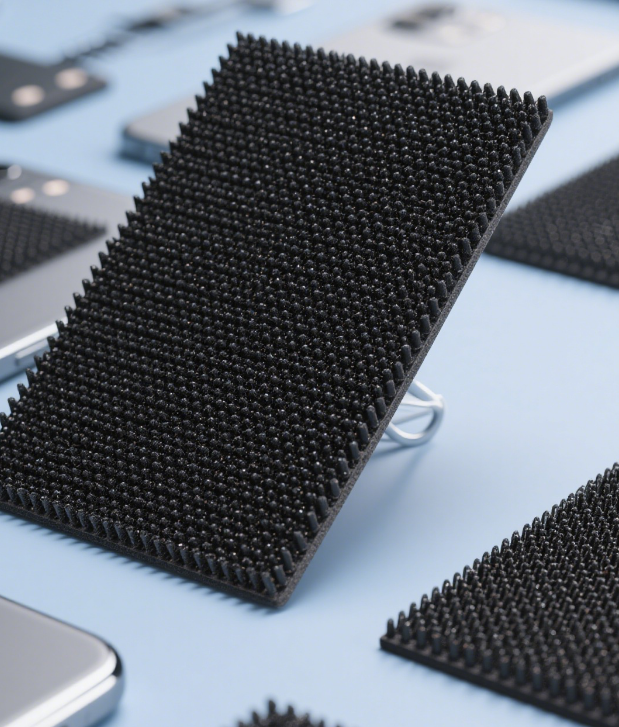Electromyographic signal conductive rubber
Electromyographic signal conductive rubber is a composite material that combines electrical conductivity with rubber elasticity, specifically designed for the efficient collection and transmission of electromyogram (EMG) signals from muscles. Its core lies in optimizing the ratio of conductive filler to rubber matrix to achieve a balance among signal quality, comfort, and durability. It is widely used in the fields of medical rehabilitation, sports science, and wearable devices.
- Material Composition and Working Principle
Matrix Material
Commonly used silicone rubber or polyurethane rubber has high elasticity (tensile rate ≥ 550%) and biocompatibility. For example, silicone rubber can maintain stability in an environment ranging from -50°C to 200°C, making it suitable for long-term wearing.
Conductive Filler
Metallic types: Silver powder (conductivity ≤ 0.002Ω・cm), nickel-coated copper powder (low cost and oxidation-resistant).
Carbon-based types: Graphene (conductivity 2.8-6.3S/cm), carbon nanotubes (good dispersibility).
Composite filler: Melamine cyanurate sponge coated with a copper layer after carbonization, and the electroplating technology is used to improve the electrical conductivity stability (volume resistivity ≤ 0.01Ω・cm).
Conduction Mechanism
Chain conduction path: The filler particles form a continuous conductive network under pressure, suitable for static signal collection.
Tunneling effect: When the particle spacing ≤ 1nm, electrons conduct through quantum tunneling, and the conductivity is maintained even under dynamic stretching.
- Performance Advantages and Technical Challenges
Core Advantages
High conformability: The elastomer can adapt to the skin’s curved surface, reducing motion artifacts. For example, MIT’s “banana” robot achieves tactile perception through knitted conductive rubber.
Low impedance: The volume resistivity of silver-filled conductive rubber can be as low as 0.004Ω・cm, approaching that of metal electrodes.
Biological safety: The solvent-free ionic conductive elastomer (SF-supra-ICE) crosslinks IP6 molecules through hydrogen bonds, avoiding skin irritation.
Technical Bottlenecks
Balance between conductivity and elasticity: A high filler content (such as silver powder ≥ 200 parts by weight) will reduce the tensile strength (from ≥ 2.07MPa to 1.38MPa).
Long-term stability: Skin oils and sweat may cause the oxidation of silver fillers, and antioxidants (such as 0.5-1.5 parts of anti-aging agents) need to be added.
Cost control: The dispersion process of graphene and carbon nanotubes is complex, resulting in high costs.
III. Preparation Process and Application Scenarios
Key Processes
Mixing and vulcanization: Silicone rubber and conductive filler are mixed in a two-roll mill, and the vulcanization temperature is 150-170°C for 0.5-1 hour.
3D printing: The MIT team has attempted 3D printing of conductive rubber, but it is limited by material fluidity and cost.
Surface treatment: The polydopamine coating enhances the adhesion of the copper layer and improves the electrical conductivity stability.
Typical Applications
Medical rehabilitation: The self-adhesive conductive rubber electrode of Suzhou Leps replaces the traditional silicone rubber, reducing cross-infection.
Wearable devices: The “ionic tattoo” (I-tattoo) developed by Jilin University achieves high-fidelity EMG signal collection, and its long-term stability is better than that of traditional electrodes.
Human-computer interaction: MIT’s pneumatic soft robot realizes tactile feedback through conductive rubber, facilitating the research and development of exoskeleton gloves.
- Comparison with Traditional Electrodes
Characteristics Conductive Rubber Metal Electrode
Comfort Soft and conformable, suitable for long-term wearing Rigid contact, likely to cause skin allergies
Signal Quality Stable signals under dynamic stretching (tunneling effect) Significant motion artifacts
Cost Moderate (depending on the filler type) High (precious metals)
Anti-interference Electromagnetic shielding effectiveness reaches 120dB (10GHz) No shielding function
- Future Development Directions
Material Innovation
Self-healing technology: The self-healing conductive rubber developed by the team of Zhenan Bao can automatically heal within 1 minute after being cut, suitable for long-term monitoring.
Nanocomposites: improves the mechanical strength (tensile strength ≥ 3.80MPa) and environmental stability through a multiple cross-linking network.
Process Optimization
In-situ forming (FIP): The dispensing technology enables the manufacturing of complex structures, used for high-density EMG electrode arrays.
Flexible electronics integration: Transistors and sensors are directly printed on the conductive rubber to reduce signal transmission loss.
Clinical Transformation
Personalized customization: Design the shape of the electrode based on the patient’s muscle distribution to improve the signal collection efficiency.
Intelligent analysis: Combine AI algorithms to process EMG data in real time for the evaluation of rehabilitation effects.
- Typical Products and Data
Product Filler Volume Resistivity Tensile Strength Application Scenarios
Nickel-coated copper conductive rubber Nickel-coated copper powder ≤ 0.004Ω·cm ≥ 1.38MPa Military electromagnetic shielding
Graphene-modified silicone rubber Graphene 2.8-6.3S/cm ≥ 6.5MPa Flexible sensors
Solvent-free ionic conductive elastomer IP6 molecules 3.3×10⁻²S/m Skin-like elasticity Skin electronics (I-tattoo)
The application of conductive rubber in the field of EMG signals is moving from the laboratory to industrialization. Its core value lies in taking into account both signal quality and user experience. With the progress of materials science and manufacturing processes, conductive rubber is expected to become a key basic material for flexible electronics and precision medicine in the future.
















